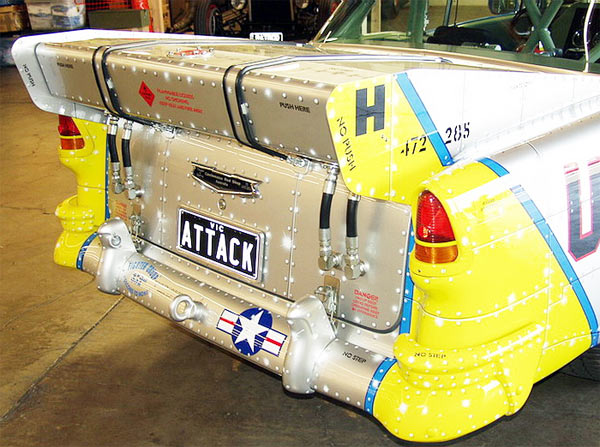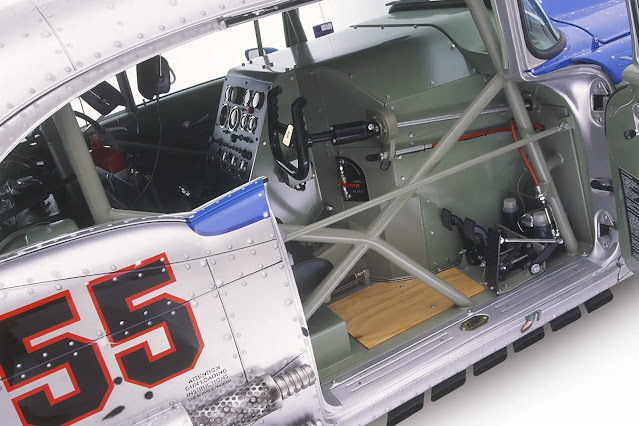"You'll Never Walk Alone"
Sunday, September 12, 2021
Thursday, December 5, 2019
Ejection Seat
What is an Ejection Seat?
Once clear of the aircraft, the ejection seat deploys a parachute
Zero-Zero ejection seat -
Now this is what we want!
The zero-zero capability was developed to help aircrews escape upward from unrecoverable emergencies during low-altitude and/or low-speed flight, as well as ground mishaps.
Parachutes require a minimum altitude for opening, to give time for deceleration to a safe landing speed. Thus, prior to the introduction of zero-zero capability, ejections could only be performed above minimum altitudes and air-speeds. If the seat was to work from zero (aircraft) altitude, the seat would have to lift itself to a sufficient altitude.
- A rescue seat for the Driver / Pilot.
- As this is a ground operated vehicle, it needs to be a 'Zero - Zero" type seat.
- This will require the seat to be rocket powered to 'clear' and 'deploy'.
- A parachute to land the seat and Driver safely.
- "End of Life" or "Terminate Mission" protocol for the safety of bystanders.
- "Dead Stop" - Integration to all systems after seat deployment - this is to ensure the safety of all at ground zero.
Further Resources needed:
- Rocket technology - to propel the seat 30 m into the air.
- Air Bag deployment technology - split second response timing.
- Altitude monitoring technology - to deploy parachute at precise moment.
- PD technology - Parachute Deployment by means of an explosive charge.
- HMD - Helmet mounted display for driver.
- Safety Harness / Neck Support / Quick Release System - Seat Evacuation Hardware - SEH
Friday, March 23, 2018
Hybrid Engine Drive Technology.
Read the complete article here.
https://hybridzigzag.blogspot.com.au/2017/12/final-drive-transmission.html
Wednesday, December 27, 2017
Alternator.
Bosch 24 volt Alternator - 55 AH
Saturday, November 18, 2017
1955 Chevy powered by P51 Mustang V12 engine.
A famous man once said "I have a dream"
Well it turns out we all have a dream.
Question is though : "Do you have the persistence and resilience to chase and catch your dream?"
Here is one man that did, and in the process inspired many of us to dream and invent!
Thank you Mr. Hadfield.
Merlin V12 Powered 55 Chevy Documentary.
Perhaps a bit O/T, but if someone can shove a V12 Merlin into a car, it deserves a bit of love and attention, and Australian Rod Hadfield 55 Chevy deserves just that. Rod spent 15 years to build his 1955 Chevy and faced many engineering issues to make his car street legal and at the same time be rated for safety.
V12 P51 Mustang Powered 1955 Chevy Start up
Here are some great detailed photo's.

**SOLD ON BILL OF SALE ONLY**
Rod Hadfield already was one of Australia’s leading Hot Rodders, a founding member of the country’s dry lakes racing organization and reportedly the first to exceed 200 miles per hour on the alkaline bed of Lake Gairdner, Down Under’s version of Bonneville.
Hadfield’s Castlemaine Rod Shop employed around 100 people and specialized in manufacturing hot rod equipment and converting American cars — especially Ford Mustangs — to Australia’s right-hand steering wheel placement.
But before he was ready to retire, Hadfield had one more thing he wanted to do. He wanted to build the world’s highest-horsepower street legal car. It took him some six years, but he worked with Australian government officials to assure his car could be licensed once it was done.
The car has working lights and turn signals and all of that. But it also has a 3000-horsepower supercharged 1650cid V12 Rolls-Royce Merlin P51 Mustang aircraft engine that formerly had propelled the Miss Budweiser unlimited hydroplane.
And Hadfield’s choice for a vehicle to carry the powertrain wasn’t an Aussie Holden or even a Down Under Ford, but a 1955 Chevrolet two door hardtop, and not just any ‘55 Chevy, but one that had been owned by American actress Ava Gardner. The car had been all but destroyed in a crash. While visiting the United States in 1986, Hadfield acquired what was left of the car and took it back to Australia.
One of his staffers worked on nothing else for five years. It took two fabricators working full time just to create the frame and modify the bodywork and craft an aircraft-style cockpit. To make everything fit, the engine had to be mounted backwards in the front of the car and a special step-down 2-speed transmission had to be fabricated to fit beneath the floorboard.
There were many other unique or unusual components: 18” wide rear wheels, a rear end from a Chevy work truck, modified disc brakes from a Ford F350 truck with six-piston Wilwood calipers, 12- and 24-volt electrical systems, front and rear radiators, huge tanks to carry fuel and oil, hydraulic jacks that can lift the car off the ground and even a way to remove the entire body when it comes time to do such things as replace the spark plugs.
Even the “standard” equipment was impressive; the engine displaces 27 liters and has a flywheel that’s three inches thick. And once they were done, it took the painter 11 months to turn the car into a road-going lookalike for one of the famed 352nd fighter group’s World War II Mustangs, complete with its “Final Objective” aircraft “nose art.”
Based at Bodney in England, the 352nd was known as the “Blue-Nosed Bastards of Bodney” — “blue-nosed” because their airplanes all had blue-painted nose sections and “bastards” because they had downed some 729 enemy aircraft while losing only 29 of their own, in the process earning “ace” honors for 29 of its pilots.
Once it was finished, at what he estimates to be a cost of around $1 million, Hadfield brought the car to the United States.
“He had the Guinness Book people out there and he submitted it, but I never heard what happened, whether it got put in the record book or not,” said Charley Lillard, a Muscle car collector who bought the car from Hadfield. “He was selling his business and retiring,” Lillard said.
“I drive it, but only a little bit. Usually around the holidays, people in my town have relatives coming to visit and everyone wants to bring them to see it,” Lillard said. “It’s kind of an attention-getter, more attention than I want to attract.
“I live out in the country, and recently I drove it down to the corner. By the time I got there, there were six cars pulled over because they saw it coming.”
Needless to say, the “Final Objective” draws a lot of attention. Early in 2003, Australia’s Cruzin magazine devoted a 26-page “mega-feature” to the car.
“When you do finally get to see the car in all its glory, do yourself a favour and appreciate it for everything that has gone into it,” the magazine noted in the issue’s editorial.
“Consider the huge number of parts and components that had to be made; not just brackets but whole gearboxes with moving parts. Have some appreciation for the amount of thought and effort that has gone into displaying the car.” The editorial also noted that Hadfield had a special truck built to haul that car to shows, where it would be displayed with a full array of World War II artifacts.
Lillard is bringing the car to Barrett-Jackson, in part because he’s ready to sell it, in part because he hopes it might find a new home parked next to a vintage Mustang fighter.
With its 2-speed transmission and all that power, Lillard said driving the car more closely resembles taxiing an airplane.
“You’re just idling it around,” he said, “though you can cruise along at any speed you like. The car weighs 7,000 pounds and has a very nice ride.”
The car also carries 70 gallons of fuel. “I think it’s not miles per gallon but gallons per mile,” he added.
Lillard said the engineering and fabrication work needed to build the car is amazing, and so is the paint job. The car appears to have rivets, just like the Mustang fighter plane. However, on the car those rivets are only paint.
“Each rivet is at least three colors, to give it the shadowing,” Lillard said. “That means they masked and sprayed at least three times for each rivet — and there’s more than 6,000 of them on the car.”
“The ‘55 Merlin Chevy is right up there with Robosaurus in my opinion,” said Gary Bennett, Barrett-Jackson’s vice-president of consignment. “It’s so out there. This is an outrageous vehicle. It’s inexplicable.
“As someone with a mechanical engineering and architectural background, I know that to take a car like that ‘55 Chevy and to remake it to accommodate that engine is nothing short of an engineering masterpiece. To think of the number of hours of just thinking through the process, and to keep the car’s integrity in place, it’s amazing.”
— By Larry Edsall

Friday, November 3, 2017
Strip Rebuild and Final Assembly Worksheet
Structural Worksheet.
Worksheet 1
- Strip down the entire Rod to bare metal.
- Weld all joints and inspect integrity.
- Grind and clean up all joints and edges
- Fit the rear boot hinges.
- Fit the rear 'dog tail'
- Fabricate exhaust bracket from engine to frame.
- Weld drip feed oiler to rod chassis.
- Weld pressure gauge perch to rod chassis.
- Mount radio comms box to LHS mudguard.


































